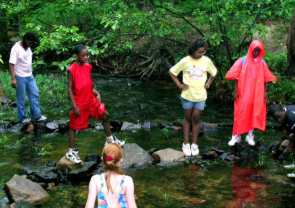SierraScape February - March 2006
Back to Table of Contents
by Jill Miller
Why do we love escaping into nature?

|
| Photo courtesy of Frank Lorberbaum |
| Kids who are most at-risk from air pollution enjoy Pickle Creek in Hawn State Park on a Sierra Club Inner City Outing. |
One of the many reasons is that a day hike or canoe outing lets us treat our cardiovascular systems to cleaner, healthier air. We can tell the difference in how the air tastes, far away from car exhaust, power plants and industrial emissions. A daily dose of pollution can harm anyone, but it affects some communities more than others.
Late in 2005, the Associated Press released an analysis of a government research project that was little-known to the public. Working with government scientists, the AP generated pollution risk scores for every neighborhood counted by the Census Bureau in 2000. Then they studied racial and economic status data to find out who is breathing the unhealthiest air in the country.
The analysis reveals that African-Americans are "79 percent more likely than whites to live in neighborhoods where industrial pollution is suspected of posing the greatest health danger."
The findings are disturbingly relevant for Missouri and the St. Louis metropolitan area. According to the AP's analysis, nearly half of Missouri's black population lives in the 10 percent of neighborhoods that earned the highest risk scores for air pollution.
The AP learned that people who live in communities with high pollution scores "also tend to be poorer, less educated and more often unemployed than those living elsewhere in the country."
This news is hardly new, unfortunately. Throughout the 1980s and 1990s, numerous studies found that blacks and poor people were significantly more likely than white and/or middle or upper-middle class people to coexist with polluting power plants, petrochemical facilities, hazardous waste incinerators, disposal sites, and industrial parks. Lack of political clout by minority communities to influence land-use decisions was considered the main reason for the disparities.
In 1994, President Clinton issued an executive order that was intended to address our country's longstanding policy of environmental injustice. More than a decade later, however, little has changed. Hurricane Katrina harshly exposed our federal government's failure to equitably implement and enforce environmental laws. Our leaders' continued disregard for the health of all communities amounts to neglect and prejudice.
In fact, the Bush administration is now attempting to redefine "environmental justice" to leave out consideration of race and income level, the greatest predictors of whether a community will face disproportionately high pollution burdens.
Short-term exposure to soot- and smog-forming air pollutants worsens existing lung conditions such as asthma and bronchitis. Long-term exposure increases the risks of developing respiratory ailments, heart disease and cancer.
The St. Louis metro area was ranked as the sixth worst "Asthma Capital" by the Asthma and Allergy Foundation of America. Asthma is the leading cause of missed school days for kids. More than 208,000 people in the Greater St. Louis Region (including the metro-east in Illinois) have asthma, according the American Lung Association, and of those, more than 53,000 are children. A chronic disease, asthma affects nearly 20 million Americans.
| TAKE ACTION! |
|---|
|
Join the fight for clean air and environmental justice!
|
The Midwest is experiencing a rush to build dozens of new coal-fired power plants. Coal, the dirtiest fossil fuel source, produces huge quantities of soot- and smog-forming pollutants such as sulfur dioxide and nitrogen oxides, toxic mercury, and lead. The plants are also major sources of carbon dioxide, the primary greenhouse gas that contributes to global warming.
In Missouri, the Sierra Club is fighting coal plant proposals near Kansas City and in Springfield.
Last November, 75 people turned out in opposition at the public hearing concerning Kansas City Power & Light's construction permit issued by the MO Department of Natural Resources. Washington University's Interdisciplinary Environmental Law Clinic represented the Missouri Sierra Club at the hearing and pointed out several serious inadequacies in the permit. The Law Clinic will also represent the Club at the appeal.
Last December, despite expert testimony provided by the Sierra Club, the Missouri Air Commission made a bad decision to approve City Utilities' coal plant proposal in Springfield. The Sierra Club has filed an appeal of that decision because the permit does not require the plant to use modern pollution controls that are already being used in other states (see press release at missouri.sierraclub.org). City Utilities still needs the approval of the city's voters, too. In 2004, citizens voted down the proposal.
No fewer than 14 new coal plants have been proposed for Illinois, the most of any state. One of the dirtiest of these is Peabody Energy's proposed Prairie State Generating Station. It would be located in rural Washington County, IL, just 45 miles from downtown St. Louis. This giant coal plant would be allowed to dump as much as 25,000 tons of new air pollution into our skies every year, according to the air permit issued by Illinois EPA. That permit is currently under appeal by Sierra Club and other health and conservation organizations across three states.
Each of these three proposed plants, if built, would add to Missouri's air pollution problems.
Healthy air is a basic right of all people, every day, not an occasional luxury-and so should be the power to protect all communities from big polluters. When we work to protect our environment, we are talking about the wild places we love to escape to, but also the places where we live and breathe.